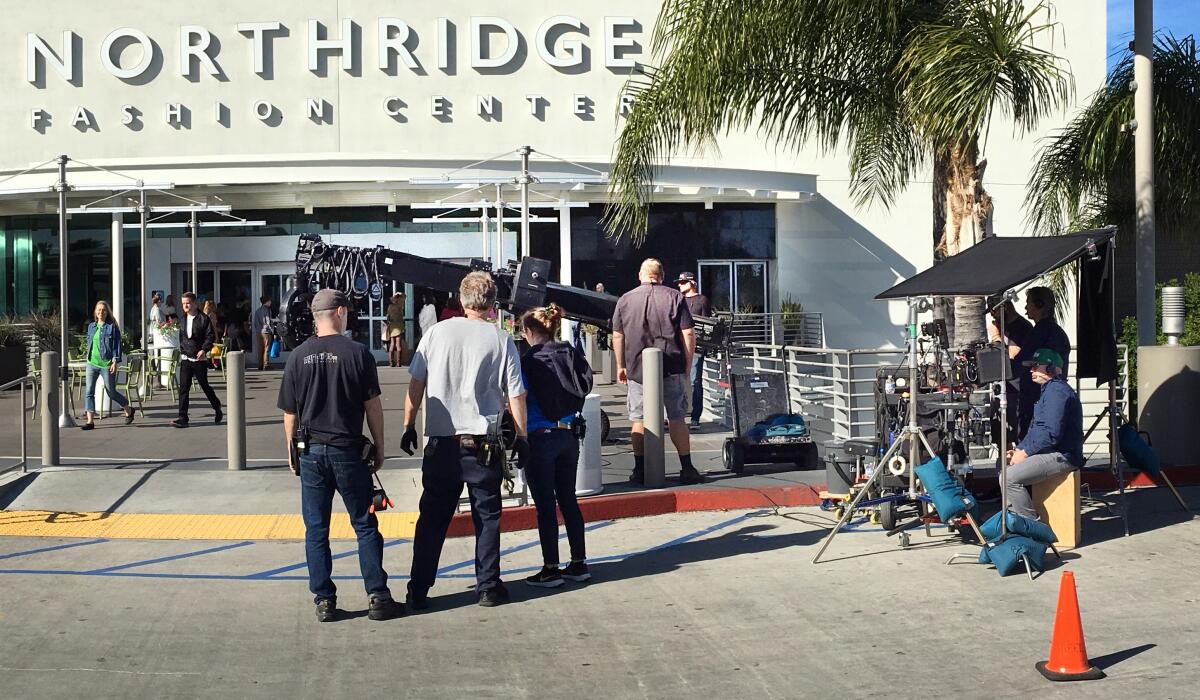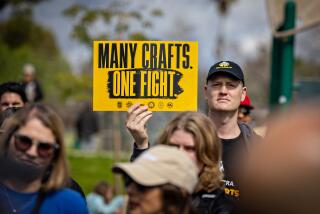Unions flex their muscle as Hollywood scrambles back to work

- Share via
For an industry brought to its knees, anxiously waiting out the coronavirus shutdown that has left thousands of entertainment workers unemployed, it wasn’t just a spot of good news but a tantalizing proposition.
Just before Memorial Day, California Gov. Gavin Newsom announced during a Zoom session with entertainment stalwarts including Netflix Chief Content Officer Ted Sarandos and Oscar-nominated director Ava DuVernay that within days, the state would issue guidelines allowing many counties to resume production, some as early as this past week.
Alas, it never came to pass.
Almost as soon as the news broke, a chorus of union representatives weighed in, putting the brakes on any imminent production reset.
“No, the industry is not going to open on Monday,” said Steve Dayan, secretary-treasurer of prominent Teamster Local 399, which represents casting directors, location managers and drivers. “We are working around the clock to get this done. We need to protect our crews but also have an obligation to protect the public.”
Newsom quickly and publicly walked back his plans. “We were hoping to put out those guidelines as early as today,” he said during a press briefing on Tuesday. “We want to extend them to later in the week, perhaps into the weekend, because we are working with both industry and labor and they want to tighten up some aspects of their guidelines.”
It was a dramatic about-face, but the pushback also demonstrated the clout of Hollywood unions and the central role they are playing in determining when and how production rolls again.
“The [Hollywood] unions are in a position to push on safety from a national standpoint in a way most unions are not,” said Kevin Klowden, executive director of the Milken Institute’s Center for Regional Economics. “It’s significant because in this situation they suddenly become a lot more powerful than normally expected.”
Hollywood is eager to get back to work after the coronavirus outbreak, but union officials, studio executives and others must first agree on new protocols to make filming safe again.
By shining a light on health and safety issues, the pandemic has elevated the crucial part the unions play in establishing safe working conditions. But while the current situation may give the unions more leverage, it also has created a raft of unprecedented challenges in balancing their need to call “action,” protect jobs and do so safely.
Over the decades, as the authority and influence of organized labor in most sectors of the American economy has diminished, Hollywood guilds and unions continue to hold firm. They have a say in almost every role of filming, from makeup artists to the actors to the prop masters.
“In many ways, this should be the domain of the unions,” said Kate Fortmueller, a University of Georgia professor of entertainment and media studies who has focused on labor issues.
“For decades, they looked at and implemented policy and procedures to ensure set safety. It’s a huge part of what they do,” she said. But she noted, in light of the pandemic, “there are a lot of stakeholders interested in putting plans in place to allow people to work.”
In recent weeks, the unions and guilds worked separately and together, forming an industrywide safety committee task force to develop a white paper to submit to the governors of California and New York. Various studios and production companies also have been fashioning their own plans.
Despite reports of turf battles, the DGA, the performers union SAG-AFTRA and IATSE, which represents crew technicians, issued a joint statement Wednesday saying they have been working together with “unprecedented frequency and productivity” on the proposed white paper. “We all want folks to get back to work as soon as possible, but we need to do it right,” they said.
For now, there are numerous proposals under discussion but no uniform set of guidelines, no determination of how much these new measures will cost or who will pay for them. Moreover, there is no official sign-off on any of them.
Earlier this month, a preliminary draft of production protocols being discussed at Lionsgate was leaked. Among the recommendations: the use of computer-generated extras instead of background actors, virtual reality location scouting and the adoption of “French hours,” restricting shoots to 10-hour days and giving crews rolling lunch breaks.
Other ideas being floated among studios and production companies include having actors do their own hair and makeup and the use of smaller crews.
The unions have, not surprisingly, pushed back.
This month, SAG-AFTRA warned its members against accepting work without first consulting the union. In a notification sent to members, it said, “No member should return to work under an existing contract or accept a contract for new employment without first securing the approval of the union.”
Hollywood’s largest guild stated that it wanted to evaluate whether the employer’s production plans comply with safety protocols, state and federal guidelines and collective bargaining agreements. They also warned members against waiving employer liability for their health and safety.
In recent weeks, as several countries have courted production, touting their generous incentives, facilities, low COVID-19 numbers, testing and measures to keep productions safe and minimize outbreaks, other unions have weighed in.
IATSE, which has been hiring epidemiologists to help formulate reopening procedures, cautioned that its eventual guidelines would be in play regardless of where filming took place, whether it be Georgia or Iceland.
The high-wire act for the unions is that while they have a great deal of power, they also have members who’ve been idle for months and are itching to get back to work. In ensuring the safety of its members, the unions also must be mindful of not placing too many onerous conditions on the process, or they risk alienating members.
“Everyone wants to go back and make money, but we all want to live as well, and we want everyone we work with to be safe,” said Gary Lennon, the showrunner on the Starz series “Hightown.” “I think there is a middle ground [and] we all have to meet there. I don’t think unions will be greedy. I think in order to get back to work all sides have to bend. Yes, the unions are in a strong position. But if the unions are too difficult, we won’t get back to work and that’s not in anybody’s interest.“
This balancing act may necessitate unions making short-term concessions, but that could be difficult to recalibrate once things go back to a semblance of normal, Fortmueller said. For instance, if they agree to deploy technology rather than background actors to reduce exposure, “How do you implement that without losing ground in the future?”
Ivy Kagan Bierman, an entertainment lawyer at Los Angeles-based partner at Loeb & Loeb, said unions are aware that their members are eager to resume working. “They know they want and need to get back to work and want to ensure that they do so safely,” she said.
Unions have the right to safeguard working conditions, as part of their collective bargaining agreements, Bierman noted. At the same time, she believes it is in their best interest to work collaboratively with studios and other players to come to a mutual agreement.
“I think it will hurt them more than help them if they don’t do that, if members feel unions are standing in the way of working and if companies are doing what they need to do to create safe workplaces,” she said.
For their part, most union representatives argue that they can and will be able to come up with reasonable solutions to protect members’ jobs and safety.
“It’s in the best interest of everyone, both employers and workers, to come up with the safest possible way to make this work and deliver the same quality with the same efficiency that we have always done,” said John Lindley, national president of the International Cinematographers Guild.
“We can innovate ways to do it safely with the same crews we have worked with traditionally,” he added. “The biggest possible impediment will be if we go back to work unsafely and people get sick. That’s the impediment that I’m in fear of and I think everybody is. That is why it is taking a long time for these protocols to be relevant and accurate and up to date.”
Any way you look at it, this pandemic will trigger dramatic shifts in TV and film production. However this unfolds, the unions are likely to hold the upper hand.
“The unions have a lot more impact than [at] a meat-packing plant or a union auto body shop,” Klowden said. “That is an important thing to keep in mind. If a production goes off the rails because of infections, you can’t simply move it to another plant. You can change the city but not the people. That is what gives the unions a lot more influence.”
More to Read
Inside the business of entertainment
The Wide Shot brings you news, analysis and insights on everything from streaming wars to production — and what it all means for the future.
You may occasionally receive promotional content from the Los Angeles Times.












